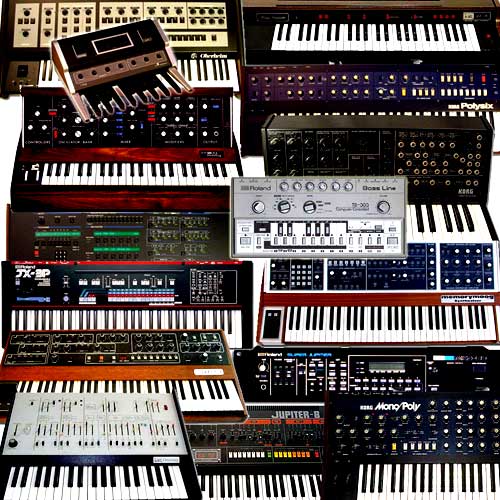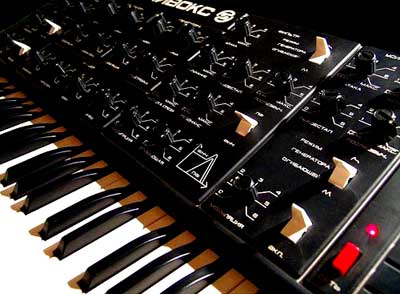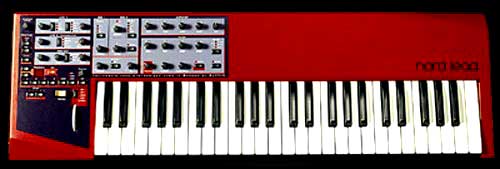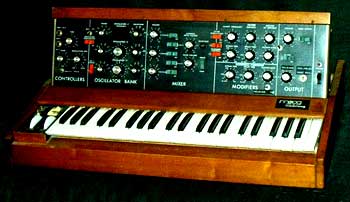Advertisement
Blog Archive
- ► 2021 (1)
- ► 2019 (3)
- ► 2017 (1)
- ► 2016 (7)
- ► 2015 (5)
- ► 2014 (26)
- ▼ 2013 (40)
- ► 2012 (34)
History of synthesizers
History of synthesizers

Today we will talk about the history of the main, perhaps, modern musical instruments, tools, committed in the last century created a furor, tools, without which we would not know such thing as electronic music. We'll talk about those instruments that we all constantly use in our music experiments, when working on any track.
They appeared as they unfolded, and what came? Let's take a fascinating historical walk from the end of the XIX century to the present day!
1876-1935
The history of the invention can be considered unusual telegraph piano-keyboard in two octaves and a built-in speaker more than a hundred years ago, at the end of the XIX century (1876). It was another experiment with the possibilities of electricity, while still relatively new, fashionable, and not fully mastered the phenomenon. On the creation of full-length musical instruments then no one spoke, and seriously, probably not even thought of, but the first brick was laid - people have learned to convert electrical vibrations into sound waves and receive sounds of different timbres. And full polyphonic instrument did not take too long to wait - 21 years after the musical telegraph, in 1897 developed the first ancestor of modern synthesizers - Telharmonium 1, created by an American engineer Todeusom Cahill. This monster does not weigh much as two tons, and most of it held the generator unit, consisting of 147 dynamos.
Time passed, technology improved, and in 1935 appeared the first tool put into production and is a bit like a modern synth-organ Hammond. Lawrence Hammond and his bodyAnd although at the time , as is usually the case , the development of popularity has not received the true recognition of the instrument came a few decades later in the era of rock music. It was used by many famous musicians , such as , for example, Deep Purple. Of course , this tool has not been fully electronic. Rather, it could be called electro - it used magnetic coils to generate electrical oscillations required height and special rotating wheel with projections . Using electric motors wheels were set in motion , and depending on the number of projections determined height fluctuations.
1955-1980
Further, as we all know, the Second World War, during which people were involved in the development of a different kind. And after ten years, in the fifties were first developed tools to create new timbres - synthesizers in their usual understanding and working principle. It was the development of RCA - Mark I in 1955, and a few years later, in 1959 - Mark II.
Tools are not widely popular due to very high cost and inconvenience of gigantic proportions in management. Modules Mark II took up an entire room, demanding hours of setup, and music giant could play only on a pre-recorded program, and it is at a cost of 175 thousand dollars! And although at this stage people have already mastered the technology to create such tools, instruments, these were rather scientific and technical experiments.
Same mass, industrial production synthesizers began when developer Robert Mugu managed to create a much more affordable, though still relatively expensive instruments - about 7000 dollars a minimal version. And the greatest popularity was received synthesizer Minimoog, whose price was only $ 1,500, and small dimensions allow its use in virtually any environment.
Minimoog called simply furor ! Thus appeared the first available analog synthesizers and that's when synthesizers started their ceremonial procession to the masses.
They have many advantages: a relatively low cost , portability , ease of use. No need to be a programmer or engineer to adjust or repair the instrument , and do not need to be a keyboardist to play it . And because of the relative technical simplicity of synthesizers and low prices on electronics components , virtually anyone who was somehow friendly with linstock and is familiar with the basics of electronics , he could assemble his own synthesizer.
USSR
Soviet Union, where U.S. development at the time, of course, were not available, developed quite independently from the west and would not leave. In 1957 colonel of artillery and inventor Eugene Murzin developed the first Soviet ANS synthesizer, and synthesis technology used in it is different from American.
In ANS used photo-optical technology of synthesis and were presented very interesting features, such as data storage on removable media (it was something of a kind used in the first Soviet computer punch cards - glass plate with a non-drying paint and transparent bar codes carrying information about a piece of music). ANS also had some sort of RAM, making it much more similar to modern synthesizers, appeared worldwide much later.
This synthesizer is used to create special effects for such films as " Solaris", " Mirror", " Sibiriada " and became classics of Soviet cinema movie " The Diamond Arm" .And throughout the rest of the world of classical synthesis technology developed actively , being tested successfully in rock and pop musicians , and by the end of the next decade, was finally formed the principles of sound synthesis . Synthesizers have found those elements which we can see them now - a few wave generators , noise generator , filters. There LFOs (LFO), through which it was possible as often as necessary to change any of the parameters (for example, open and close the filter ) , and envelope generators , with which we could make the sound of the desired shape. There are the first samplers and drum machines .
1980-1995
People gradually come to those technologies that we use now in full swing. With one small exception - there was no standard sequencers and MIDI, which does not take long and was developed in the early 80s.
In synthesizers appeared comfortable unified protocol.
From MIDI possibility to manage a variety of synthesizers with sequencer or MIDI-keyboards only transmit signal and synthesizing sound independently. There are opportunities to record the party and then play the sound you want is already recorded MIDI-signal at the desired instrument. Began to appear miniature racks devices without a keyboard. At the same time appeared the first romplery - synthesizers, working on the basis of pre-recorded and their inherent sample and not have their own generators. Traditional forms of classical wave generators - sine, sawtooth, square and triangular, - added a lot of new waveforms found in other instruments. So the opportunity to simulate the synthesizer any "live" tool. In the mid eighties began to appear workstations, in which one unit was placed multitrack sequencer and drum machine. This gave the musicians the opportunity, with one such station to write full composition, mimicking the sound of the whole group.The Soviet Union, virtually cut off from imported products, meanwhile, continued to issue their own instruments. So, there were tools like ALICE, Polivoks, ELECTRONICS, Junost.

Synthesizer Polivoks
With the development of computer technology and the constant improvement of the power of the then computers began to appear the first software sequencers, which, of course, it was impossible to compare their current brothers, whether Cubase, Logic, or Protools, but their modest possibilities was enough to make the process of recording and editing is much more visible.
Computer and digital technology has evolved a ten steps, there were new types of synthesis, all the more powerful sequencers and samplers capacious.
1995 - the emergence of digital synthesizers
Since the first Moog synthesizers development and long after all the synthesizers were analog and worked on the classical scheme. However, the growth of digital technology did not fail to have an effect on this industry. So, in 1995 the Swedish company Clavia introduced the first "virtual analog" or more simply, digital synthesizer Nord Lead.

In this device against classical generators used a digital emulation of analog synthesis.
Classical concepts here are aligned with the new digital technology - instead of the traditional circuits used special processors , very truthfully imitated warmth and beauty of sound "real" , fully analog instruments . Externally tool differed little from their senior colleagues - on the front panel was attended by all of the same controls . But added some very comfortable , typical figures for technology - the ability to store in the memory of the instrument and to keep back a large number of banks with presets , the unit had updated the OS.
It was the first, and very insistent call to the world of digital synthesizers and digital cameras from other developers do not have to wait long.
Particularly successful young companies, such as, for example, Access Music, the manufacturer is very popular nowadays synthesizer Virus.
Digital synthesizers became overgrown with fitted units rather qualitative effects on board any modern digital synth has a minimum unit reverb and delay, and in many cases, and effects such as chorus / flanger / distortion.
Of devices, just make sounds, synthesizers escalated into a full-fledged workstation.
Virtual Instruments
With the power capacity of computers made possible the emergence of the first software synthesizers.
In the 96th German company Steinberg announces a new truly revolutionary technology - Virtual Studio Technology (VST) and the first sequencer with support for this format - Cubase VST. And the standard VST sequencer Cubase itself and then worked exclusively on the platform Apple Macintosh. It was an absolute innovation, and no program at the time, worked for the PC could not boast of such opportunities.
Cubase VST for MacOS
Cubase VST immediately gained immense popularity among professional musicians.
Two years later, the standard VST and ported to PC, at the same time appears to Cubase VST PC. Thus becomes multiplatform VST format, which gives him a lot of advantages, especially for plugin developers than the last, and did not fail to take advantage of.
With the growth of technology and the increasing capacity of computers, software tools and processing have become increasingly popular. Sequencers began to appear on third-party manufacturers with support for VST, such as, for example Ematic Logic, Sonar, Fruity Loops
In addition there were also other VST plug-in formats, such as, for example, the native format for Windows applications, DirectX, quickly and successfully move who came VST format and subsequently appeared proprietary format Apple - AU (Audio Unit). To ProTools formats were developed TDM (DSP-processors are counted ProTools) and RTAS (CPU are counted). However, the number of plug-ins developed by sequencers and VST format was and remains unrivaled.
In 2000 there appeared the first version of Reason - integrated software studio that includes a sequencer, and tools. Reason does not support any VST, or other formats plug plug, but thanks to a decent built-in tools received significant popularity among electronic musicians.
Of course, the first software synthesizers had pretty miserable by modern standards, the sound could not be compared with their full-bodied counterparts iron, but the technology was very promising, because when the first of our usual software sequencers like Cubase and Reason, people had the opportunity to play music, having only one computer.
A technology started successfully and rapidly, processing power is measured by thousands of megahertz, computers have become powerful enough to pull a variety of complex transactions in real time. Sequencers and software tools developed following them and also become much more powerful, functional, and, of course, demanding.
Hardware and software bundles
Very popular in professional circles steel hardware and software bundles. We're not talking about ProTools, and on synthesizers such as Access Virus Ti and processor UAD and PowerCore.
Such links allow you to control the hardware capabilities through normal VST / AU / RTAS-plugins. Virus Ti synthesizer allows you to manage both software and hardware, such as processing packages as UAD and PowerCore is a special board with DSP-processor and a set of high-quality plug-ins, these processors cheated.
Management plug synthesizer Virus Ti
It's easy, convenient, economical. Whole inch rackmount switch with all the wires you can now replace a single card that is inserted into the slot PCI Express.
Processing fee UAD-2 Quad with 4 DSP-processors
Of course, the cost of such boards as UAD-2 (about 50 thousand rubles) can be compared with the cost of decent rack processing devices, but ease of switching and sound quality of these packages are worth it.
Such solutions are very popular now, and no doubt will be further developed. I bet in a few years, almost all produced tools will be able to complete software control.
Summarizing
Now, for the full writing quality music now powerful enough to have a computer with the necessary software, sound card and a pair of high-quality monitors. The main thing - to know your tools and be able to get from it is the sound that you want.
And here you can not do without the basic knowledge of the principles through which the synthesis of sound, what are the kinds of synthesis, and how synthesizers work. Responsible for what, what pen, as the sound is formed and through which it passes.
-
Tags:
- analog synthesizers
- synth












Comments
of his site, for the reason that here every material is quality based
material.
RSS feed for comments to this post